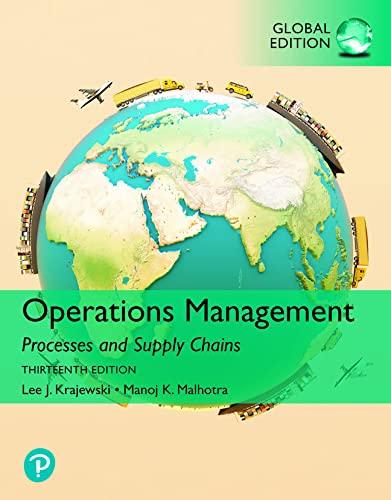John Wolf, president of Wolf Motors, just returned to his office after visiting the company's newly acquired
Question:
John Wolf, president of Wolf Motors, just returned to his office after visiting the company's newly acquired automotive dealership. It was the fourth Wolf Motors dealership in a network that served a metropolitan area of 400,000 people. Beyond the metropolitan area, but within a 45-minute drive, were another 500,000 people. Each of the dealerships in the network marketed a different brand of automobile and historically had operated autonomously. Wolf was particularly excited about this new dealership because it was the first "auto supermarket" in the network. Auto supermarkets differ from traditional auto dealerships in that they sell multiple brands of automobiles at the same location. The new dealership sold a full line of Chevrolets, Nissans, and Volkswagens.
Starting 15 years ago with the purchase of a bankrupt Dodge dealership, Wolf Motors had grown steadily in size and in reputation. Wolf attributed this success to three highly interdependent factors. The first was volume.
By maintaining a high volume of sales and turning over inventory rapidly, economies of scale could be achieved, which reduced costs and provided customers with a large selection. The second factor was a marketing approach called the "hassle-free buying experience." Listed on each automobile was the "one price-lowest price." Customers came in, browsed, and compared prices without being approached by pushy salespeople. If they had questions or were ready to buy, a walk to a customer service desk produced a knowledgeable salesperson to assist them. Finally, and Wolf thought perhaps most importantly, was the after-sales service. Wolf Motors established a solid reputation for servicing, diagnosing, and repairing vehicles correctly and in a timely manner-the first time.
High-quality service after the sale depended on three essential components.
First was the presence of a highly qualified, well-trained staff of service technicians. Second was the use of the latest tools and technologies to support diagnosis and repair activities. Third was the availability of the full range of parts and materials necessary to complete the service and repairs without delay. Wolf invested in training and equipment to ensure that the trained personnel and technology were provided. What he worried about, as Wolf Motors grew, was the continued availability of the right parts and materials.
This concern caused him to focus on the supplier relationship process and management of the service parts and materials flows in the supply chain.
Wolf thought back to the stories in the newspaper's business pages describing the failure of companies that had not planned appropriately for growth. These companies outgrew their existing policies, procedures, and control systems. Lacking a plan to update their systems, the companies experienced myriad problems that led to inefficiencies and an inability to compete effectively. He did not want that to happen to Wolf Motors.
Each of the four dealerships purchased its own service parts and materials.
Purchases were based on forecasts derived from historical demand data, which accounted for factors such as seasonality. Batteries and alternators had a high failure rate in the winter, and air-conditioner parts were in great demand during the summer. Similarly, coolant was needed in the spring to service air conditioners for the summer months, whereas antifreeze was needed in the fall to winterize automobiles. Forecasts also were adjusted for special vehicle sales and service promotions, which increased the need for materials used to prep new cars and service other cars.
One thing that made the purchase of service parts and materials so difficult was the tremendous number of different parts that had to be kept on hand. Some of these parts would be used to service customer automobiles, and others would be sold over the counter. Some had to be purchased from the automobile manufacturers or their certified wholesalers, and to support, for example, the "guaranteed GM parts" promotion. Still, other parts and materials such as oils, lubricants, and fan belts could be purchased from any number of suppliers. The purchasing department had to remember that the success of the dealership depended on
(1) Lowering costs to support the hassle-free, one price-lowest price concept,
(2) Providing the right parts at the right time to support fast, reliable after-sales service. As Wolf thought about the purchasing of parts and materials, two things kept going through his mind: the amount of space available for parts storage and the level of financial resources available to invest in parts and materials. The acquisition of the auto supermarket dealership put an increased strain on both finances and space, with the need to support three different automobile lines at the same facility. Investment dollars were becoming scarce, and space was at a premium. Wolf wondered what could be done in the purchasing area to address some of these concerns and alleviate some of the pressures.13
QUESTIONS
1. What recommendations would you make to John Wolf with respect to structuring the supplier relationship process for the Wolf Motors dealership network?
2. How might purchasing policies and procedures differ as the dealerships purchase different types of service parts and materials (for example, lubricants versus genuine GM parts)?
3. How can supply chain design and integration help John Wolf reduce investment and space requirements while maintaining adequate service levels?
Step by Step Answer:

Operations Management Processes And Supply Chains
ISBN: 9781292409863
13th Global Edition
Authors: Lee Krajewski, Naresh Malhotra, Larry Ritzman





